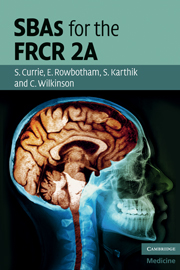Book contents
- Frontmatter
- Contents
- List of contributors
- Preface
- Introduction
- Module 1 Cardiothoracic and vascular
- Module 2 Musculoskeletal and trauma
- Module 3 Gastro-intestinal
- Questions
- Answers
- Module 4 Genito-urinary, adrenal, obstetrics & gynaecology and breast
- Module 5 Paediatric
- Module 6 Central nervous and head & neck
- References
- Index
Answers
Published online by Cambridge University Press: 06 July 2010
- Frontmatter
- Contents
- List of contributors
- Preface
- Introduction
- Module 1 Cardiothoracic and vascular
- Module 2 Musculoskeletal and trauma
- Module 3 Gastro-intestinal
- Questions
- Answers
- Module 4 Genito-urinary, adrenal, obstetrics & gynaecology and breast
- Module 5 Paediatric
- Module 6 Central nervous and head & neck
- References
- Index
Summary
1. c. Hypoperistalsis in the upper third of the oesophagus
The oesophagus is the most commonly involved location of the gastro-intestinal tract in patients with scleroderma. Smooth muscle atrophy causes hypoperistalsis and eventually aperistalsis in the lower two-thirds of the oesophagus. The upper third of the oesophageal wall contains skeletal muscle and is therefore unaffected by the disease process.
(Ref: Dahnert p. 863)
2. d. Ipsilateral rib fractures
All are potential associated injuries and should be actively searched for in the context of blunt abdominal trauma. Rib fractures are found in up to 50% of patients with splenic injuries and as such are the most common association. The left kidney is injured in 10% of patients with splenic injury, and diaphragm rupture is even rarer. Diaphragm rupture may be difficult to appreciate on axial slices, and may be more evident on coronal reformats.
(Ref: Dahnert p. 807)
3. a. Type B
Congenital TE fistula and oesophageal atresia occur in approximately 1 in 4000 live births. They are divided into five subtypes, A to E. Type C is the most common, comprising 75% of all types and involves oesophageal atresia with a distal TE fistula. Type D involves oesophageal atresia with both proximal and distal TE fistula, and type E is a TE fistula without oesophageal atresia. Therefore types C to E do not typically present with gasless abdomen.
- Type
- Chapter
- Information
- SBAs for the FRCR 2A , pp. 62 - 74Publisher: Cambridge University PressPrint publication year: 2010



